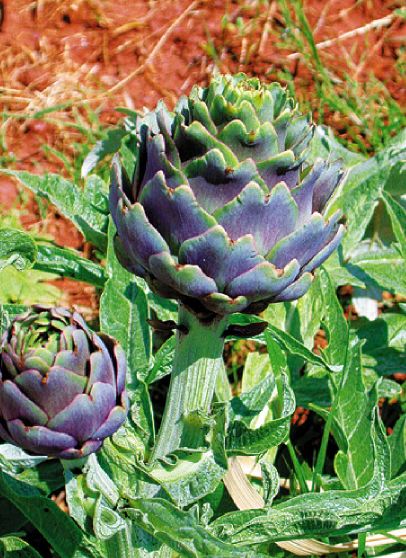 |
||
|
Healthy Artichokes by Marianthi Milona |
||
|
IT HAS such a wonderful mauve colour, but, unfortunately, that is the time when the artichoke (Cynara scolymus) is no longer of any interest for the gourmet. With its origins in Iran or Arabia, the artichoke in its modern form is a comparatively new vegetable in Greece, arriving via Italy only in the late 15th century. Artichokes, which are sensitive to frost, thrive primarily in the warm Mediterranean climate. All plantings of this thistle-like herbaceous plant, which grows nearly 7 feet (2 metres) tall, need to be rejuvenated roughly every four years, as yield declines with age. It is not generally known, but the fields of the Peloponnese produce many thousands of tonnes of artichokes for the international market and that Greece is the world's seventh largest producer. The main areas where artichokes have managed to make their way into Greek cuisine are the Dodecanese and the Ionian Islands. Like cauliflower and broccoli, it is grown for its flower heads; in other words, it is the closed flower bud, either whole or in part, that is eaten, usually the flower head base (the "heart") and the fleshy parts of the scales, which overlap like roof tiles and surround the base. This means that barely 20 percent of the flower head is edible. When preparing artichokes, the woody stalk should be completely removed. The artichoke buds are then totally immersed in boiling salted water and cooked in a covered pan. |
 |
|
|
In most cases, only the artichoke hearts are used in the kitchen. They are usually served with olive oil, plenty of lemon juice, fresh herbs, and also with asparagus. But in recent years, more and more people have discovered the upper side of the hard leaves, which, it is said, are good for those who have high cholesterine levels. Arnaki me anginares (Lamb with artichokes) Ingredients 2/3 cup / 150ml Greek extra virgin olive oil 2 lb / 1kg shoulder lamb, diced 5 cups finely chopped onion 8 small artichokes 2 eggs Juice of 1 lemon 1 bunch dill, finely chopped Salt Freshly ground white pepper Method Heat the olive oil in a pan. First brown the meat, then add the onions and soften. Season with salt and pepper, then add a generous 2 3/4 cups / 700ml water. Lower the heat and braise the meat until tender. Cut back the artichoke stems to 3/4in (2cm). Remove the tough outer leaves and cut off the tips of the inner leaves. Rub all cut surfaces with lemon juice. Leave for 25-30 minutes, then place the artichokes, stem up, in the pan, adding more hot water if necessary, and cook for 10-15 minutes over a constant low heat. Remove from the heat and leave to cool slightly. Break the eggs into a bowl and beat until frothy. Add the lemon juice and some of the cooking liquid, beating continuously. Add the egg and lemon sauce to the braised meat, stir, sprinkle with dill and serve with freshly baked white bread. Anginares yemistes (Stuffed artichoke hearts) * Marianthi Milona is the author of the book Culinaria Greece |
||
(Posting date 3 June 2008)
All articles of Athens News appearing on HCS have been reprinted with permission. |
||
|
||
|
2000 © Hellenic Communication Service, L.L.C. All Rights Reserved.
http://www.HellenicComServe.com |
||

